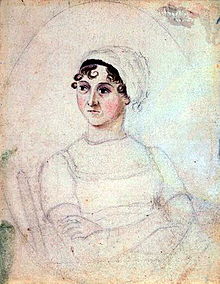 On this day in 1817, novelist Jane Austen died in Winchester, England at the age of 41. Born 16 December 1775 at Steventon Rectory in Steventon, Hampshire, England. In my opinion, one of the great English writers.
On this day in 1817, novelist Jane Austen died in Winchester, England at the age of 41. Born 16 December 1775 at Steventon Rectory in Steventon, Hampshire, England. In my opinion, one of the great English writers.
With the publications of Sense and Sensibility (1811), Pride and Prejudice (1813), Mansfield Park (1814) and Emma (1816), she achieved success as a published writer. She wrote two additional novels, Northanger Abbey and Persuasion, both published posthumously in 1818, and began another, eventually titled Sanditon, but died before its completion. She also left behind three volumes of juvenile writings in manuscript, a short epistolary novel Lady Susan, and another unfinished novel, The Watsons. Her six full-length novels have rarely been out of print, although they were published anonymously and brought her moderate success and little fame during her lifetime.
A significant transition in her posthumous reputation occurred in 1833, when her novels were republished in Richard Bentley’s Standard Novels series, illustrated by Ferdinand Pickering, and sold as a set. They gradually gained wider acclaim and popular readership. In 1869, fifty-two years after her death, her nephew’s publication of A Memoir of Jane Austen introduced a compelling version of her writing career and supposedly uneventful life to an eager audience.
Austen did not marry.
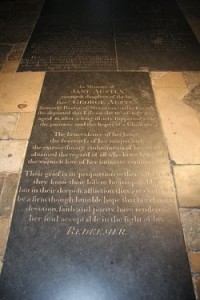 The Final Footprint – Austen is entombed in the north aisle of the nave of Winchester Cathedral. Her inscription reads; “In memory of JANE AUSTEN, youngest daughter of Rev GEORGE AUSTEN, formerly Rector of Steventon in this court. She departed this life on the 18th of July 1817, aged 41, after a long illness supported with the patience and the hopes of a Christian. The benevolence of her heart, the sweetness of her temper, and the extraordinary endowments of her mind obtained the regard of all who knew her and the warmest love of her intimate connections. Their grief is in proportion to their affection they know their loss to be irreparable but in their deepest affliction they are consoled by a firm though humble hope that her charity, devotion, faith and purity have rendered her soul acceptable in the sight of her REDEEMER.” The term Janeite has been embraced by devotees of the works of Austen.
The Final Footprint – Austen is entombed in the north aisle of the nave of Winchester Cathedral. Her inscription reads; “In memory of JANE AUSTEN, youngest daughter of Rev GEORGE AUSTEN, formerly Rector of Steventon in this court. She departed this life on the 18th of July 1817, aged 41, after a long illness supported with the patience and the hopes of a Christian. The benevolence of her heart, the sweetness of her temper, and the extraordinary endowments of her mind obtained the regard of all who knew her and the warmest love of her intimate connections. Their grief is in proportion to their affection they know their loss to be irreparable but in their deepest affliction they are consoled by a firm though humble hope that her charity, devotion, faith and purity have rendered her soul acceptable in the sight of her REDEEMER.” The term Janeite has been embraced by devotees of the works of Austen.
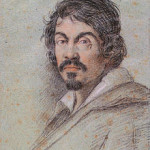 On this day in 1610, Italian artist active in Rome, Naples, Malta, and Sicily between 1593 and 1610, Caravaggio died in Porto Ercole, Tuscany at the age of 38. Born Michelangelo Merisi on 29 September 1571 in Milan. His paintings, which combine a realistic observation of the human state, both physical and emotional, with a dramatic use of lighting, had a formative influence on the Baroque school of painting. Caravaggio trained as a painter in Milan under Simone Peterzano who had himself trained under Titian. Caravaggio’s novelty was a radical naturalism that combined close physical observation with a dramatic, even theatrical, use of chiaroscuro. This came to be known as Tenebrism, the shift from light to dark with little intermediate value. He burst upon the Rome art scene in 1600 with the success of his first public commissions, the Martyrdom of Saint Matthew and Calling of Saint Matthew. Thereafter he never lacked commissions or patrons, yet he handled his success poorly. Famous while he lived, Caravaggio was forgotten almost immediately after his death, and it was only in the 20th century that his importance to the development of Western art was rediscovered. His influence on the new Baroque style that eventually emerged from the ruins of Mannerism was profound. It can be seen directly or indirectly in the work of Rubens, Jusepe de Ribera, Bernini, and Rembrandt, and artists in the following generation heavily under his influence were called the “Caravaggisti” or “Caravagesques”, as well as Tenebrists or “Tenebrosi” (“shadowists”). It can be said that in what begins in the work of Caravaggio is modern painting.
On this day in 1610, Italian artist active in Rome, Naples, Malta, and Sicily between 1593 and 1610, Caravaggio died in Porto Ercole, Tuscany at the age of 38. Born Michelangelo Merisi on 29 September 1571 in Milan. His paintings, which combine a realistic observation of the human state, both physical and emotional, with a dramatic use of lighting, had a formative influence on the Baroque school of painting. Caravaggio trained as a painter in Milan under Simone Peterzano who had himself trained under Titian. Caravaggio’s novelty was a radical naturalism that combined close physical observation with a dramatic, even theatrical, use of chiaroscuro. This came to be known as Tenebrism, the shift from light to dark with little intermediate value. He burst upon the Rome art scene in 1600 with the success of his first public commissions, the Martyrdom of Saint Matthew and Calling of Saint Matthew. Thereafter he never lacked commissions or patrons, yet he handled his success poorly. Famous while he lived, Caravaggio was forgotten almost immediately after his death, and it was only in the 20th century that his importance to the development of Western art was rediscovered. His influence on the new Baroque style that eventually emerged from the ruins of Mannerism was profound. It can be seen directly or indirectly in the work of Rubens, Jusepe de Ribera, Bernini, and Rembrandt, and artists in the following generation heavily under his influence were called the “Caravaggisti” or “Caravagesques”, as well as Tenebrists or “Tenebrosi” (“shadowists”). It can be said that in what begins in the work of Caravaggio is modern painting.
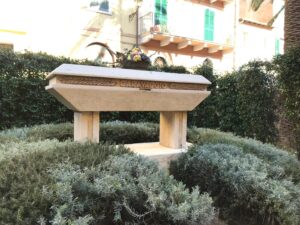 The Final Footprint – His death is the subject of much confusion and conjecture. On 28 July an anonymous avviso (private newsletter) from Rome to the ducal court of Urbino reported that Caravaggio was dead. Three days later another avviso said that he had died of fever on his way from Naples to Rome. A poet friend of the artist later gave 18 July as the date of death, and a recent researcher claims to have discovered a death notice showing that the artist died on that day of a fever in Porto Ercole, near Grosseto in Tuscany. Human remains found in a church in Porto Ercole in 2010 are believed to almost certainly belong to Caravaggio. The findings come after a year-long investigation using DNA, carbon dating and other analyses. Some scholars argue that Caravaggio was murdered by enemies he may have made in Malta. Caravaggio might have died of lead poisoning. Bones with high lead levels were recently found in a grave likely to be Caravaggio’s. Paints used at the time contained high amounts of lead salts. Caravaggio is known to have indulged in violent behavior, which can be caused by lead poisoning. Caravaggio’s epitaph was composed by his friend Marzio Milesi. It reads: “Michelangelo Merisi, son of Fermo di Caravaggio – in painting not equal to a painter, but to Nature itself – died in Port’ Ercole – betaking himself hither from Naples – returning to Rome – 15th calend of August – In the year of our Lord 1610 – He lived thirty-six years nine months and twenty days – Marzio Milesi, Jurisconsult – Dedicated this to a friend of extraordinary genius.”
The Final Footprint – His death is the subject of much confusion and conjecture. On 28 July an anonymous avviso (private newsletter) from Rome to the ducal court of Urbino reported that Caravaggio was dead. Three days later another avviso said that he had died of fever on his way from Naples to Rome. A poet friend of the artist later gave 18 July as the date of death, and a recent researcher claims to have discovered a death notice showing that the artist died on that day of a fever in Porto Ercole, near Grosseto in Tuscany. Human remains found in a church in Porto Ercole in 2010 are believed to almost certainly belong to Caravaggio. The findings come after a year-long investigation using DNA, carbon dating and other analyses. Some scholars argue that Caravaggio was murdered by enemies he may have made in Malta. Caravaggio might have died of lead poisoning. Bones with high lead levels were recently found in a grave likely to be Caravaggio’s. Paints used at the time contained high amounts of lead salts. Caravaggio is known to have indulged in violent behavior, which can be caused by lead poisoning. Caravaggio’s epitaph was composed by his friend Marzio Milesi. It reads: “Michelangelo Merisi, son of Fermo di Caravaggio – in painting not equal to a painter, but to Nature itself – died in Port’ Ercole – betaking himself hither from Naples – returning to Rome – 15th calend of August – In the year of our Lord 1610 – He lived thirty-six years nine months and twenty days – Marzio Milesi, Jurisconsult – Dedicated this to a friend of extraordinary genius.”
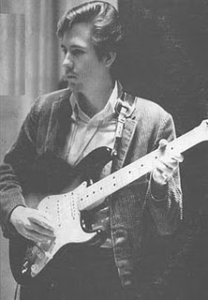 On this day in 1966, rock singer, songwriter, and guitarist, Bobby Fuller died in Los Angeles at the age of 23. Fuller was found dead in an automobile parked outside his Hollywood apartment. The Los Angeles deputy medical examiner, Jerry Nelson, performed the autopsy. Reportedly the autopsy states; “The report states that Bobby’s face, chest, and side were covered in “petechial hemorrhages” probably caused by gasoline vapors and the heat. He found no bruises, no broken bones, no cuts. No evidence of beating.” The boxes for “accident” and “suicide” were ticked, but next to the boxes were question marks. Despite the official cause of death, some believe Fuller was murdered. Born Robert Gaston Fuller on 22 October 1942 in Baytown, Texas.
On this day in 1966, rock singer, songwriter, and guitarist, Bobby Fuller died in Los Angeles at the age of 23. Fuller was found dead in an automobile parked outside his Hollywood apartment. The Los Angeles deputy medical examiner, Jerry Nelson, performed the autopsy. Reportedly the autopsy states; “The report states that Bobby’s face, chest, and side were covered in “petechial hemorrhages” probably caused by gasoline vapors and the heat. He found no bruises, no broken bones, no cuts. No evidence of beating.” The boxes for “accident” and “suicide” were ticked, but next to the boxes were question marks. Despite the official cause of death, some believe Fuller was murdered. Born Robert Gaston Fuller on 22 October 1942 in Baytown, Texas.
Perhaps best known for his singles “I Fought the Law” and “Love’s Made a Fool of You,” recorded with his mid-1960s group, the Bobby Fuller Four.
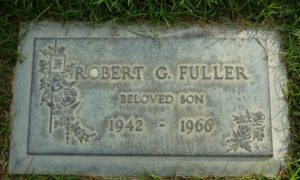 The Final Footprint – He is interred in Forest Lawn Memorial Park Hollywood Hills in Los Angeles. Other notable final footprints at Hollywood Hills include; Gene Autry, David Carradine, Scatman Crothers, Bette Davis, Sandra Dee, Ronnie James Dio, Michael Clarke Duncan, Andy Gibb, Carrie Fisher, Michael Hutchence, Jill Ireland, Al Jarreau, Lemmy Kilmister, Jack LaLanne, Nicolette Larsen, Liberace, Strother Martin, Ricky Nelson, Bill Paxton, Brock Peters, Freddie Prinze, Lou Rawls, John Ritter, Debbie Reynolds, Telly Savalas, Lee Van Cleef, Paul Walker, and Jack Webb.
The Final Footprint – He is interred in Forest Lawn Memorial Park Hollywood Hills in Los Angeles. Other notable final footprints at Hollywood Hills include; Gene Autry, David Carradine, Scatman Crothers, Bette Davis, Sandra Dee, Ronnie James Dio, Michael Clarke Duncan, Andy Gibb, Carrie Fisher, Michael Hutchence, Jill Ireland, Al Jarreau, Lemmy Kilmister, Jack LaLanne, Nicolette Larsen, Liberace, Strother Martin, Ricky Nelson, Bill Paxton, Brock Peters, Freddie Prinze, Lou Rawls, John Ritter, Debbie Reynolds, Telly Savalas, Lee Van Cleef, Paul Walker, and Jack Webb.
#RIP #OTD in 2015 actor (Moe Greene in The Godfather) Alex Rocco died from pancreatic cancer in his Studio City home, at the age of 79. Cremation
Have you planned yours yet?
Follow TFF on twitter @RIPTFF

